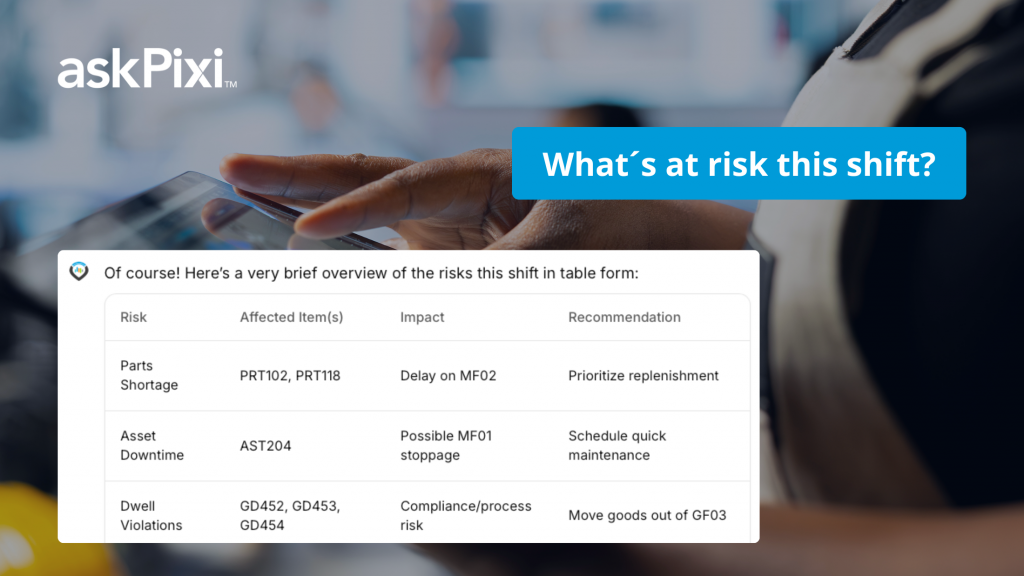
Planning in supply chain and production is rarely stable. Every day, unexpected events disrupt operations: materials arrive late, employees call in sick, machines produce defects. Each of these incidents cascades through the process chain, forcing plans to be adjusted again and again.
For many managers, this is daily reality. But the real challenge is not just the disruptions themselves – it’s also the enormous time required to deal with them.
The hidden time sink in planning teams
To build a reliable planning basis, data must be pulled together from many different systems, such as: ERP, MES, WMS, transport or shift planning tools. Only after this reconciliation does a complete picture emerge that supports decisions.
But that picture is often outdated within hours. New disruptions occur, priorities shift, delivery dates slip. The result: constant replanning.
Studies show that planners spend up to 50% of their time collecting, cleaning, and preparing data before they can even make a decision (source: SupplyChainTrend). Another survey found that supply chain professionals spend on average 14 hours per week – nearly two full workdays – manually tracking data (source: SalesTechStar). This ties up valuable capacity and delays action.
Classic planning works – but it’s too slow
Traditional planning methods remain valuable. But they are heavily manual and too slow for today’s dynamic supply chains. In many companies, changes are still tracked in Excel or discussed through endless email chains and meetings.
That not only delays reactions but also creates errors — manually merging data from different sources increases the risk of inconsistencies. Research in Applied Sciences highlights that even short supply delays and out-of-stock situations can lead to significant revenue losses within just a few weeks. A clear sign of how costly late or inaccurate planning decisions can be.
Why location data matters
Many companies are exploring using AI in planning. But without the right context, AI remains blind. This is where real-time location systems (RTLS) come into play: they capture the position and movement of assets, materials, or vehicles in real time.
Location data adds the time and space dimension that systems like ERP or MES cannot provide. It enables managers to answer questions such as:
- Where exactly is material X – in storage, in transit, or already at the line?
- How long has an order been waiting at a workstation?
- Which resources are currently free – or blocked?
Combined with AI, this information creates a comprehensive operational picture that enables real-time decision-making.
Location data and AI as accelerators

This is where agentic AI comes in. It doesn’t replace planning teams – it reduces the manual workload that consumes so much of their time.
- Speed: Data from ERP, MES, WMS and RTLS is automatically combined. Events that used to take hours to detect become visible in seconds.
- Error reduction: AI checks data consistency, flags deviations, and recommends corrective actions.
- Decision support: Instead of chasing data, teams can focus on making the right calls to secure delivery reliability and efficiency.
Example: A delay in material XYZ would normally trigger a chain of calls and meetings across planning, purchasing, and logistics. With AI, the impact is detected instantly (or even predicted!), alternatives are evaluated, and concrete recommendations are presented before the disruption reaches the customer. A practical example of this approach is askPixi, Inpixon’s location-aware AI solution.
Act now – not later
The question is no longer if AI and location data will be used in planning and logistics, but when. In the US, many companies are already applying such solutions and building competitive advantages (source: TrueCommerce). Those still debating Excel formatting risk falling behind.
Planning teams need speed and reliability today. Early adopters of AI reduce their manual workload, avoid costly mistakes – and gain back the time needed for the decisions that really matter.
Conclusion
Supply chain planning will always be complex and essential. But it doesn’t have to remain a daily time sink. With location data and Agentic AI, routine work can be automated, risks flagged earlier, and decisions made faster.
It’s not just about preventing the next bottleneck – it’s about securing long-term competitiveness.
For those who want to dive deeper
On September 30, we will host a free live demo showing how location data and AI are being applied in industrial environments. (If the webinar date has already passed at your time of reading this, register anyway for the recording.) Register here!
—-
Sources:
- SupplyChainTrend (2022): Intelligent IBP – a new role for supply chain planners
- SalesTechStar (2023): Survey reveals supply chain workers spend almost two days a week manually tracking data
- TrueCommerce (2023): Mitigating supply chain delays – top stresses and solutions


Leave a Reply